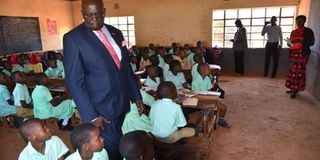Schools to teach learners on safety

Education Cabinet Secretary George Magoha monitoring safety
measures at Kakamega Primary School on March 6, 2020. PHOTO | ISAAC WALE | NATION MEDIA GROUP
What you need to know:
- The bill was introduced by Turkana Woman Rep Joyce Emakor
- The overall objective of the Act is to enhance the country’s disaster preparedness and reduce disaster risks especially in learning institutions.
Schools will now be required to teach learners safety precautions, how to detect acts of terrorism and defend themselves as part of the curriculum.
This is after President Kenyatta signed into law a new Bill that mandates schools to provide the necessary knowledge on how learners can defend themselves in case of an attack.
The Kenya Institute of Curriculum Development amendment Act, 2019, mandates curriculum developers to incorporate personal safety and psychosocial skills training in the curricula for basic and tertiary institutions.
The amendment bill was signed into law on Thursday.
The law is meant to enhance the country’s disaster preparedness especially in learning institutions. The bill was introduced by Turkana Woman Rep Joyce Emakor.
REALITIES OF LIFE
KICD acting CEO Joel Mabonga said the law is timely as it creates an opportunity for those charged with improving curriculum delivery methods, to ensure it responds to emerging realities of life.
“We shall implement the law as passed by Parliament and sanctioned by the President in line with the Competency Based Curriculum (CBC),” Dr Mabonga said at KICD.
According to the bill, KICD will “in cooperate personal safety, self-defence, and demonstrations on security drills, first aid detection and response to weapon and evaluation procedure in curriculum development.”
It also mandates KICD to incorporate psychological skills and services to students’ curriculum development as well as develop learning materials to help reduce disaster risk.
The country has faced various forms of disasters which include floods, fires, droughts and terrorism threats that have not spared even schools.
PREVENTIVE MEASURES
Dr Mabonga said some of them could have been averted if the right values and preventive measures were integrated in the learning process, early enough.
“Safety measures and disaster preparedness in schools and other learning institutions cannot be wished away if we have to minimise the threat of damage to property and loss of life,” Dr Mabonga said.
Currently, the school curricula does not provide the learners with education on safety particularly on how to conduct security drills, evacuation, first aid, .
It also does not educate them on how to sense danger and other safety related teachings.
The overall objective of the Act is to enhance the country’s disaster preparedness and reduce disaster risks especially in learning institutions.
In the event of a disaster, safety of children, teachers and staff members would be guaranteed if learners and teachers are well versed with the basic disaster response measures.





